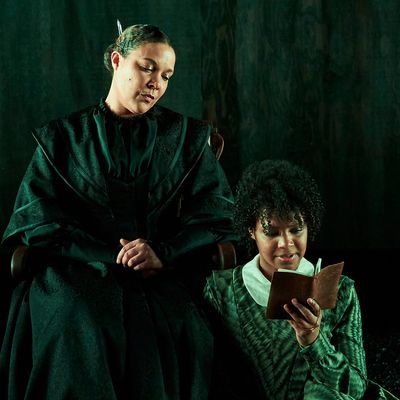
The Playwrights Realm enjoyed a major success last year with The Wolves, a marvelous, eye-opening play by Sarah DeLappe that flipped the tropes of the men-in-sports genre to explore the lives of a fieldful of young women. Jen Silverman’s The Moors, which opens tonight in another handsome production by the same company, tries to do something similar with the romantic-psychological novels of the Brontë sisters, repurposing bits of their plots (and the sisters’ own biographies) into a story of women flourishing in the wild. But whereas DeLappe’s play kept faith with the voices of its characters, Silverman’s is satirical, if weakly so, and erodes the viewer’s patience for whimsy long before it can effectively make an argument or illuminate anything real.
It’s not a case of a few cute decorations; the whimsy is hardwired. One day in the mid-19th century, Emilie Vandergaard (Chasten Harmon) arrives at an ancient manse on the English moors, where two spinster sisters, Agatha and Huldeygard, await her. (You might expect Carol Burnett and Vicki Lawrence to play the sisters, but instead it’s Linda Powell and Birgit Huppuch.) It seems that after a flirtatious correspondence with their brother, Branwell — or was it Branwell? — Emilie has been hired as a governess. In any case, Branwell is nowhere to be found. Also not in evidence is the child Emilie is meant to govern. Witless Huldeygard and severe Agatha at first offer no explanation for these absences, nor for the fact that the scullery maid, Marjory, is the same person as the parlor maid, Mallory. (One of them is pregnant and the other has typhus; both are played by Hannah Cabell.) Instead, Huldeygard indulges her mania for journaling, while Agatha lets simmer her secret plan for domination. Let’s just say that the dissolute Branwell, apparently named for the Brontës’ own dissolute brother, is imprisoned in the attic, like Mrs. Rochester of Jane Eyre.
Fans of that Charlotte Brontë novel will also recognize Huldeygard and Agatha as cartoons of its moor-bound Rivers sisters; those who prefer Emily Brontë’s Wuthering Heights may detect in Mallory/Marjory a reference to its ambiguous servant subplot. The typhus threat, here played for giggles, could come from any of the sisters’ books, or their lives, as could the characters’ obsession with Byronic ideals. Huldeygard imagines being a famous murderer, but only partly fulfills her dream. Agatha, a manipulative lesbian straight out of The Well of Loneliness — I’m surprised the manse isn’t called Radclyffe Hall — gets further with her dark and glamorous arrogance, but not quite all the way.
With its focus on women’s lives as complete unto themselves, The Moors not only passes the Bechdel test but crushes it; men are barely mentioned except as lunatics and sperm donors. The only male figure onstage, in fact, is the sisters’ sad mastiff, who has purple thoughts and privilege issues. (He is played by Andrew Garman almost as an English gentleman, in scratchy tweeds from designer Anita Yavich.) Along with a wounded moorhen (Teresa Avia Lim, in flouncy pants and capelet), the dog enacts the traditional male-female drama that The Moors otherwise abjures: the one in which marriage is the solution to a man’s problems, if rarely to a woman’s. The counterpoint fails, though, partly due to its reluctance to unpack relevant issues like free will and animal nature. But it mainly fails because, despite Garman’s dogged commitment and Lim’s avian charm, the setup is too twee to support its own weight.
The human story fares little better. To say it is imaginatively conceived is not to suggest it is fascinating or instructive. (Other people’s fantasies are usually dull.) Yes, we are interested in the question of what women might be if truly liberated from patriarchal domination, and, yes, it seems reasonable to explore that question in the context of a Brontëan wilderness in which the savagery of the environment produces savage heroines. Certainly Dane Laffrey’s scenic design, and especially Jen Schriever’s gorgeous billows of light amid the pumped-in fog, help produce the necessary sense of dislocation and grandeur. But the play keeps undermining itself with falseness on the one hand and weak attempts at humor on the other. Repurposing an old genre’s clichés to serve new ideas does not in itself do anything to revive their vigor or make them delightful. And the addition of clichés of more recent vintage — Huldeygard is for some reason given a “crazy rock power ballad” to express her inner life — just seems desperate.
You can’t really blame the four actors playing humans for not finding a tone that works, nor even the director, Mike Donahue, who staged a galvanizing, totally nonsatirical new play called Homos: Or Everyone in America last year. The fault is in the conception of the story, which wants to have its camp and eat it too. The result may be something new, but it’s the opposite of eye-opening.
The Moors is at the Duke on 42nd Street through March 25.




